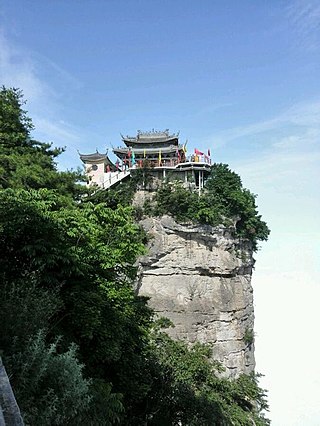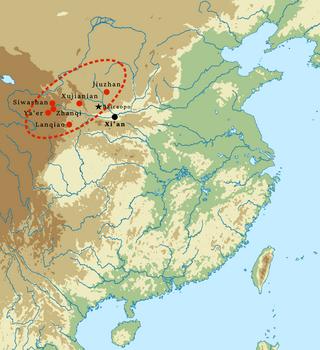
Gansu is a province in Northwest China. Its capital and largest city is Lanzhou, in the southeast part of the province.

The Qin, or as officially the Great Qin, was one of the ancient Chinese states during the Zhou dynasty. Traditionally dated to 897 BC, it took its origin in a reconquest of western lands previously lost to the Rong; its position at the western edge of Chinese civilization permitted expansion and development that was unavailable to its rivals in the North China Plain. Following extensive "Legalist" reform in the fourth century BC, Qin emerged as one of the dominant powers of the Seven Warring States and unified the seven states of China in 221 BC under Qin Shi Huang. It established the Qin dynasty, which was short-lived but greatly influenced later Chinese history.
Feizi, also known by the title Qin Ying and Ying Feizi, was the founder of the ancient Chinese state of Qin, predecessor of the Qin Dynasty that would conquer all other Chinese states and unite China in 221 BC.

Tianshui is the second-largest city in Gansu Province, China. The city is located in the southeast of the province, along the upper reaches of the Wei River and at the boundary of the Loess Plateau and the Qinling Mountains. As of the 2020 census, its population was 2,984,659 inhabitants, of which 1,212,791 lived in the built-up area made of the 2 urban districts of Qinzhou and Maiji. The city and its surroundings have played an important role in the early history of China, as still visible in the form of historic sites such as the Maijishan Grottoes.

Longnan is a prefecture-level city in the southeast of Gansu province in China. It borders Sichuan on its south and Shaanxi on its east. As of the 2020 Chinese census, the population of the prefecture-level city was 2,855,555.

Qin'an County is a county in the east of Gansu province, China. It is under the administration of the prefecture-level city of Tianshui. Its postal code is 741600, and in 1999 its population was 567,553 people. As of 2018, the population is 618,000 people. It is one of the poorest counties of Gansu, being appointed as one of 23 counties part of a provincial poverty alleviation project.

Gangu County is a county in the southeast of Gansu province, China. It is under the administration of Tianshui City and is the most populous county in Gansu. Its postal code is 741200, and in 1999 its population was 570,318 people.

Jingyuan County is a county in the east of Gansu Province. It is under the administration of Baiyin City, and consists of two separate tracts of territory to the north and south of Pingchuan District. The northern tract borders Ningxia to the north. The southern area consists of an irrigated area around the Yellow River and the northern area is semi-arid highlands.

Ning County or Ningxian is a county in the east of Gansu province, China. It is under the administration of the prefecture-level city of Qingyang. Its postal code is 745200, and its population in 1999 was 505,660 people.

Kang County or Kangxian is a county in the southeast of Gansu province, China. It is under the administration of Longnan City. The county was formed in 1928 as Wudu County, but renamed to Kang County the next year, named after the northern Zhou Dynasty place Kangzhou.

The Siwa culture was a Bronze Age culture in southeast Gansu Province, China. It was discovered by Swedish geologist Johan Gunnar Andersson in 1924 at Mount Siwa (寺洼山) in Lintao County, hence its name. It flourished circa 14th to 11th century BC, it is tentatively attributed to the cultures of the Northern Di, Qiang, and Xunyu peoples.
Qin Zhong or Zhong of Qin ,nomen unknown, was the fourth ruler of the state of Qin during China's Zhou dynasty. Qin at the time was a small fief that had been granted to his great-grandfather Feizi for his work breeding horses for King Xiao of Zhou. Qin Zhong succeeded his father Gongbo, who died in 845 BC. Their ancestral name was Ying.
Duke Zhuang of Qin was from 821 to 778 BC the fifth ruler of the Zhou Dynasty state of Qin that eventually united China to become the Qin Dynasty. His ancestral name was Ying and His Nomen is Qi.
Duke Xiang of Qin aka by his nomen ,Ying Kai ,was from 777 to 766 BC the sixth ruler of the Zhou Dynasty vassal state of Qin, which eventually unified China to become the Qin Dynasty. His ancestral name was Ying ,Kai as his nomen and Duke Xiang was his posthumous title. He was the first Qin ruler to be granted a nobility rank by the king of Zhou; under his reign, Qin was formally recognized as a major vassal state of Zhou China.
Duke Wen of Qin was the seventh ruler of the Zhou Dynasty state of Qin that eventually united China to become the Qin Dynasty. His ancestral name was Ying, nomen not known,and Duke Wen was his posthumous title.
Longxi Commandery was a commandery of imperial China in present-day Gansu, named due to its location west of Mount Long.
Tianshui Commandery, known as Hanyang Commandery during the Eastern Han dynasty, was a historical commandery of China in eastern Gansu. The modern city of Tianshui receives its name from the commandery.

Yiqu, was an ancient Chinese state which existed in the Hetao region and what is now Ningxia, eastern Gansu and northern Shaanxi during the Zhou dynasty, and was a centuries-long western rival of the state of Qin. It was inhabited by a semi-sinicized people called the Rong of Yiqu, who were regarded as a branch of western Rong people by contemporary writers, whom modern scholars have attempted to identify as one of the ancestors of the minority people in Northwest China.

China National Highway 567 runs from Lixian to where it meets G345 in Changba, Kangxian. Large parts of the route are relabeled from Gansu provincial highways S205 and S219. G7011 Shiyan–Tianshui Expressway runs parallel to the road on several sections. It is one of the new trunk highways proposed in the China National Highway Network Planning.
The 1654 Tianshui earthquake occurred on July 21 in Tianshui, Gansu Province, Ming dynasty sometime between 21:00 and 23:00 local time. The event had an estimated moment magnitude of 7.0 and was assigned a maximum intensity of XI on the China seismic intensity scale. Resulting in extreme damage and affecting at least four provinces, the quake killed approximately 30,000 people.












